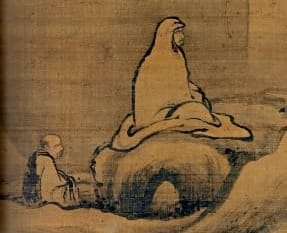Dogen's Wall-Gazing Liberates Beings
"[... By] the straightforward abandonment of skillful means and the exclusive proclamation of the supreme Buddha Way." - Zhiyi from his commentary on "The Lotus Sutra"

The previous post,"How Can I Liberate Beings Such as These? Shakyamuni Buddha's Conundrum," was a prequel to this one. It all got started several weeks ago when I translated Dogen's Eiheikoroku 268 (The Extensive Record of Eihei) – a powerful expression of zazen related to the current Vine of Obstacles Zen training theme.

Then I started writing about Eiheikoroku 268, intent on sharing it with you. But as I got into the details, I realized that to appreciate Dogen's teaching in Eiheikoroku 268, background in The Lotus Sutra that Dogen references (which forms his lived paradigm) is necessary. Dogen, you see, had spent his formative years as a Tendai (Chinese, Tiantai) monastic, a school centered on The Lotus Sutra. As they say, "You can take a kid out of Tendai, but you can't take Tendai out of the kid."
Also, as you may know, Dogen, like many Japanese masters and practitioners in his era, did not study The Lotus Sutra so much as he lived it, and that it, in fact, was him. For example, this verse from Eiheikoroku V10.99 (my recent translation):
causes me to recite the Lotus Sutra aloud constantly.
Completely focused on cultivation, dropping aversion and attachment,
gazing at the moon, listening to the rain."
Here's old Dogen blissing out in retreat, breaking into that old The Lotus Sutra tune, cultivating the Way, dropping aversion and attachment.
Question: What happened to that zazen-only guy?
Answer: Ah, he gave it all away.
In the above cited prequel post, I emphasized Shakyamuni Buddha's conundrum ("How can I teach these messed-up people?") and his resolution (at first, skillful means and then just laying it out there: only a Buddha together with a Buddha can fathom the ultimate nature of phenomena). More on that below.
Dogen's teaching in the short discourse that I'll get to below, Eiheikoroku 268, raises the same conundrum that the Buddha of The Lotus Sutra dealt with and resolved. Dogen raises and resolves this conundrum by bringing together his Tendai background as well as the function of cultivating-verification that he learned from his master, Rujing, in China.
As the Tiantai master Zhiyi put it in his commentary on The Lotus Sutra :
As in the prequel, all quotes from The Lotus Sutra are from The Threefold Lotus Sutra: A Modern Translation for Contemporary Readers, as translated by Michio Shinozaki, Brook Ziporyn, and David Earhart.

Or, on the other hand, if this is what you're looking for, you might be called to:
Now that I've done my part to prepare you, I'll offer my translation and commentary for Dogen's teaching from Eiheikoroku 268.
Well, but first, this reminder
Application deadline for the fall training intensive: 5:00pm CT, Sunday, October 12

Eiheikoroku 268. Going up to the main hall
Dogen begins:
In this discourse, Dogen addresses his assembled practitioners by exhorting them to reach the top of the mountain and to reach the bottom of the ocean. In other words, to become Buddha completely with no directionality or partiality.
Without realizing great awakening, he might have said, we really don't know shit – more delicately expressed in the "Skillful Means" chapter of The Lotus Sutra with the ten suchnesses: "... such an appearance, such a nature, such an embodiment, such a potential, such a function, such a cause, such a condition, such an effect, such a reward, and from the first to the last, such an ultimate identity.”
In other words, we know neither vast and wide of the mountains, nor the depths of the oceans, i.e., the specific nature of living beings. So in the first portion of this exhortation, Dogen calls for us to reach vast and wide and depths in this life by becoming one with Buddha.
Dogen then notes that with this knowledge of the specific phenomenal nature (by knocking the empty and conventional views into the middle) of living beings, a practitioner has some pretty cool superpowers: with one step, you step over the four great oceans, with one push, you push over Mt. Sumeru.
This echos The Lotus Sutra's descriptions of a Buddha's great functioning to liberate beings. As quoted in the prequel from The Lotus Sutra's "Skillful Means" chapter:
“Shariputra, the knowledge and insight of the tathagatas are broad, great, profound, and far-reaching. With their infinite virtues, their unhindered wisdom, and their powers, fearlessness, meditations, emancipations, and samadhis, they have entered into the boundless realms and fully attained the extraordinary Dharma."
Such great functioning, though, isn't limited to only Buddhas in far-off lands. I think, for example, of Harada Tangen Roshi (1924 - 2018) whose great functioning I saw first hand. And depending on their depth of realization, practitioners today can get a taste of such functioning too.
One such not-so-distant great-functioning practitioner was the great Hakuin (1686 - 1769). While reading this same "Skillful Means" chapter of The Lotus Sutra, he heard a cricket churring and entered great awakening. Tears of joy and relief poured from him like beans from a ruptured sack.
You might notice that The Lotus Sutra's truth – lived and realized by both Dogen and Hakuin – that we're all on the bodhisattva path and in a sense already Buddhas, doesn't deter Dogen (or Hakuin) from exhorting us to reach it.
In the prequel, I quoted Brook Ziporyn's "Introduction" on this same point:
In Eiheikoroku 268, after noting the stepping and pushing superpowers,
Dogen continues:
What do you have to let go of to be a member of this family?
What family?
That's a member of the family that can step over the four great oceans in one step and push over the mountain at the center of the world [Sumeru] in one push. The last name of this family is "What."
But, hey, what do you have to let go of to become a member? You might start by letting go of your attachment to being an ordinary being and focus your life energy on fully realizing the Buddha Way. You can do that by knowing (or rather, by being) the sparrow's chirps and the crow's caws (and the churrs of a cricket) – aka, the phenomena nature of the ten suchnesses which only a Buddha together with a Buddha can fully know.
It isn't a one-person show.
The capping verse
Dogen continues Eiheikoroku 268, first not saying anything for a good long while, and then offering a verse:
'Gazing at a tree doing kinhin for twenty-one days,
the morning star appeared illuminating the Milky Way,
and quiet sitting shattered the seat of awakening.
Who can measure the wall-gazing of my house?'"
In the first line of the verse (Gazing at a tree doing kinhin for twenty-one days), Dogen relives Shakyamuni Buddha's conundrum doing kinhin for twenty-one days contemplating a tree. Shakyamuni's conundrum, you may remember from the prequel, that he worked through while doing kinhin, was how to teach this gnarly lot (us):
"When I first sat at the seat of awakening,
Contemplated the tree, and practiced kinhin,
For a period of twenty-one days I pondered the following matter."
See "How Can I Liberate Beings Such as These? Shakyamuni Buddha's Conundrum," for a full unpacking of "the following matter." But here is my summary: Shakyamuni saw living beings who were so impoverished, perilous, suffering, attached, obsessed, greedy, blinded, and entrenched in views that he doubted that he could teach them this extremely profound and subtle Dharma.
In the second and third lines of the verse,
Dogen goes on to cite the Buddha's awakening (the morning star appeared illuminating the Milky Way, and quiet sitting shattered the seat of awakening). So rather than in The Lotus Sutra, where the Buddha first awakened and then had the conundrum arise about how to teach living beings, Dogen has the conundrum arise first and then the awakening.
In short, Dogen seems to have the timeline mixed up. A translator might be tempted to add some words into that second line so that the timeline aligns with consensus past-present-future reality. For example, one might just insert a little "after" to start the second line, even bracket it, so it would read [After] the morning star appeared illuminating the Milky Way. In so doing, the translator would note for the reader that the first line, the conundrum, came after the awakening.
But that would assume the translator was correct that Dogen was making a mistake or, perhaps, inadvertently (or stylistically) omitting time markers. Another possibility is that Dogen is demonstrating one of the key teachings of The Lotus Sutra – that causes-and-effects run in multiple directions. In this case, the present (Gazing at a tree doing kinhin for twenty-one days) gives birth to the past (the morning star appeared illuminating the Milky Way). And then sitting quietly shattered the seat of awakening.
Similarly, in Ziporyn's "Introduction" to the above translation of The Lotus Sutra, he notes that in The Lotus Sutra, "The linear time sequence of past and future is all confused."
That is:
But aren't we each a separate embodiment?
And with the final line of verse
(Who can measure the wall-gazing of my house?), there are several references that beg for unpacking in order to resolve the conundrum, now taken on by Dogen, "How can I liberate beings such as these?"
First, as for Who can measure, Dogen is going beyond the three vehicles (hearers, solitary sages, and bodhisattvas) in the same way that Shakyamuni revealed the One Vehicle. Specifically, the Tiantai fourfold of division of the teaching according the Zhiyi, has these categories (I borrow here from the Digital Dictionary of Buddhism with modifications):
- Three Baskets (Sutta, Vinaya, Abhidharma): Found in the Agama and Nikaya. This is the Small Vehicle teaching of the hearers and solitary sages, based on the four truths, focussed on saving the individual. Cultivation and verification are measurable.
- Shared: The teaching common to the adherents of the three vehicles. The shared teaching holds the perspective of emptiness, but does not arrive at the doctrine of the Middle (the integration of the empty and the conventional). So cultivation and verification are still measurable.
- Distinct: This is the teaching exclusively for bodhisattvas who have a profound understanding of conventionality and thus are able to live and work in the mundane world without being “defiled” by it (aka, practice compassion), yet have not yet perceived the full implications of the Middle that includes both emptiness and conventionality in the Perfect sense; so cultivation and verification are subtly measurable and their great functioning to liberate beings is limited.
- Perfect: Defined as a perfect whole and as complete in its parts; for the whole is the absolute and its parts are therefore the absolute; the two are emptiness and conventional, but in reality they are one, i.e. the Middle. That which is all-inclusive is immeasurable, as is their great functioning to liberate living beings.
Dogen's first Zen teacher, Eisai, also a Tendai monastic and one of the first to transmit Zen to Japan, taught that Zen in Japan could become the practical fulfillment of Zhiyi's Perfect teaching. Dogen fulfilled Eisai's prediction and resolved Shakyamuni's conundrum by directly presenting the Perfect – whether living beings see it or not.
Happily, some do see it. Later in The Lotus Sutra, for example, the four former greatest hearers, the Venerables Subhuti, Mahakatyayana, Mahakashyapa, and Mahamaudgalyayana, simultaneously realize that they'd been on the bodhisattva path all along and say in unison, This immeasurably rare treasure, which we did not seek, has come to us of its own accord.
Here are four great (former) arhats singing the Perfect together in one-part harmony – Who can measure? How could any of us know the wonder of what unfolds on this path?
Before we go into the last phrase of the final line (the wall-gazing of my house?), let's review. In the verse for Eiheikoroku 268, Dogen begins with Shakyamuni Buddha's conundrum after awakening, which creates his awakening, and shatters the seat of awakening. Then, he introduces the Perfect with Who can measure and completes the verse with the wall-gazing of my house?'"
Alright, now on to wall-gazing.
Wall-gazing refers to Bodhidharma sitting cooly and serene at Shaolin, gazing at a wall for nine years. So it turns out that at the same time Shakyamuni was doing kinhin (pre, during, and post awakening), Bodhidharma, twenty-nine generations later, was in northern China sitting and gazing at a wall in a cave at Shaolin – a distance of a thousand years and two thousand miles. Here-and-there as well as past-present-future are not lined up in the way we'd expect (again).

But it's not just Bodhidharma that's wall gazing. Dogen has joined him here with everybody in Dogen's house. That is, my house (Who can measure the wall-gazing of my house?). My house is another way of saying this family, as in What do you have to let go of to become a member of this family?
Elsewhere, Dogen says that this wall-gazing (i.e., zazen) is "[...] simply the dharma gate of peace and bliss 安樂" (also a reference to The Lotus Sutra, this time, Chapter 14: "Practices of Peace and Bliss").

In such a place, at such a time, and in such an intimate relationship, Who can measure the wall-gazing of my house? If you see this Who as a rhetorical question, Shakyamuni Buddha never did conundrum-kinhin, Bodhidharma never did wall-gazing, Dogen never dropped body-mind, Hakuin never heard a cricket churring.
How can I liberate beings such as these?
Who? How?
One might say, This immeasurably rare treasure, which we did not seek, has come to us of its own accord.

Coming soon
"Hakuin Zenji on Dying and Death"
And at Shake Out Your Sleeves and Go, "'No Quarter for Escape' an Interview with Shodhin Geiman Sensei"



